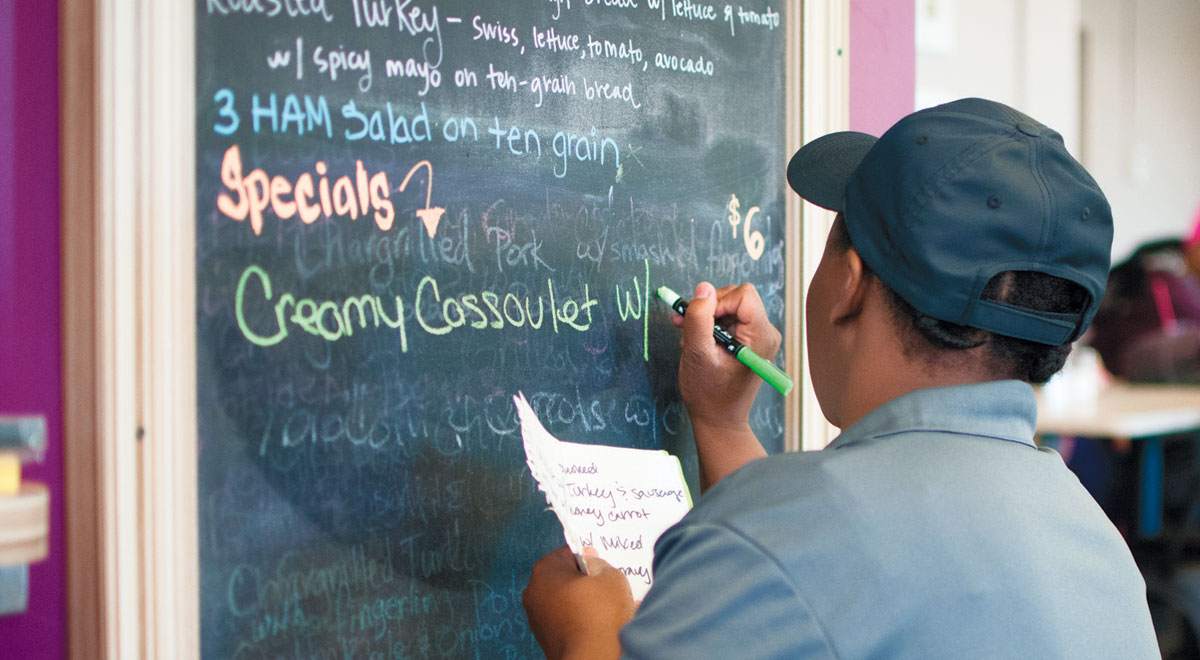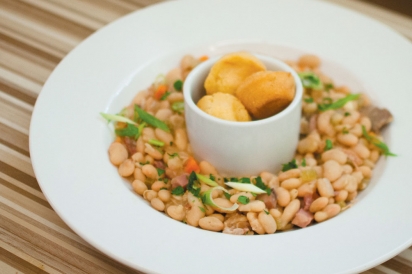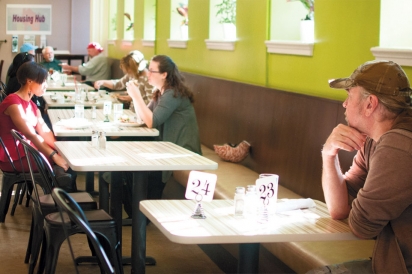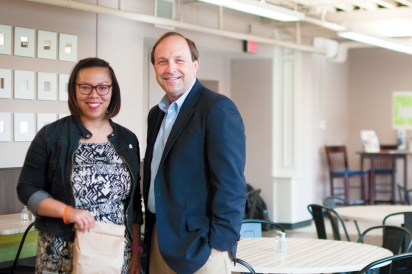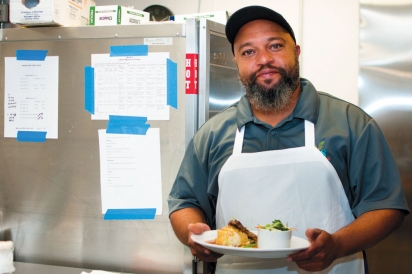Hungry Neighbors: Reimagining Fresh Food Access at the Mid-Ohio Foodbank
Thinking Beyond the Food Pantry
Imagine a restaurant open to community members from all walks of life—those who can pay for a meal as well as those who can’t. Downtown office workers power-lunching over quinoa next to hipsters brunching on hazelnut pancakes, and at the table by the window, the homeless man you recently saw on the corner gracefully enjoying ciderglazed pork chops for free.
This is the South Side Roots Cafe & Market, a vision of the Mid-Ohio Foodbank, recently opened at Columbus’ Reeb Avenue Center. South Side Roots is food access at its finest: People from all walks of life enjoying nutritious food in a community setting regardless of their ability to pay.
“This is a restaurant for everyone. This is not a food pantry or a place only for people who are low-income. This is a restaurant where everyone can get a good meal,” notes Yolanda Owens, the Mid-Ohio Foodbank communications manager.
In our community, one in six adults and one in four children face food security issues on a daily basis. South Side Roots is an innovative mixedincome model that ensures that the most vulnerable among us are able to secure fresh, healthy food in a dignified setting.
The Cafe, which operates under a “pay what you can” structure, offers diners three ways to purchase a meal: Pay the full price or less, pay the full price or more to “pay it forward” for someone less fortunate, or volunteer in the Cafe kitchen or dining room to earn your meal.
All diners enjoy a healthy meal, not knowing what or how the person next to them paid, in a space that is airy, open, and inviting.
Across the hall from the Cafe is the Market, which sells fresh produce, groceries, and a variety of ready-to-go meals at extremely discounted prices. Like the Cafe, anyone can shop at the Market regardless of income. The Market acquires food from the one of the Foodbank’s two urban farms, or it is purchased by the Foodbank at a discounted rate.
“Eighty percent of the people that come to our pantries only visit five times or less. It’s very incidental: ‘My car broke down and I have to fix it so I can go to work, which means I now can’t afford to buy groceries.’ These are people who are trying to make ends meet; they want to be able to pay. The Market is a very dignified setting where they can pay for what they need,” says Yolanda.
The Reeb Avenue Center is a collaboration of 13 nonprofits committed to making a change on the Southside of the city. The 111-year-old former school opened in late September after a $12.5 million renovation.
The neighborhood hopes that the Center will spur revitalization in this part of town. Planners believe that the Center can serve as a model for similar projects in disenfranchised neighborhoods around the city, state, and nation.
In addition to the Cafe and Market, the space also houses social service organizations devoted to adult education and job training, as well as a new branch of the Columbus Boys & Girls Club and the Southside Learning and Development Center.
“We believe it is important to serve the whole person and co-locating with these amazing partners here at the Reeb Center allows us to share our work,” says Matt Habash, president and CEO of the Foodbank.
Programs offered by the partners interweave organically with the Cafe and Market: The Godman Guild’s job training program places participants in the Cafe; the Cafe’s kitchen provides nearly 400 fully subsidized meals daily to attendees of the Columbus Boys & Girls Club program and the Southside Learning and Development Center; additionally, nutrition and wellness programs are offered in the Cafe space by Community Development for All People, another partner in the building.
On a recent afternoon, David Cofer, managing director of Community Development for All People, lunched with several colleagues in the Cafe. “There are a lot of places that we could have chosen to have lunch at today but part of our being here is to support this vision that we helped to craft—this vision of people from many different backgrounds eating together,” he says. “What an incredible meal, at an amazing price, for a great cause.”
A Model in Fresh Food Access
The Mid-Ohio Foodbank is strategically investing in programs to get fresh food into the hands of those who need it and, today, nearly 53% of the food distributed by the organization is fresh.
In 2014, through the help of its more than 650 partners, the Foodbank distributed nearly 24 million pounds of fresh food to its clients. Feeding America, a nationwide network of food banks, ranks the Mid-Ohio Foodbank as sixth best in the country, among a group of 200 peers, in making fresh food a reality for those that the organization serves.
In a recent survey, 84% of a sample of Foodbank clients reported that their biggest barrier to accessing fresh food is not location, but cost. They noted that there may be a grocery store in their neighborhood, however, they often don’t have the funds to pay for fresh food at the store.
“Even if there is a grocery store in a community, if people cannot afford it, then they still do not have access. True access also includes affordability,” notes Yolanda.
To tackle the issue of cost, which affects hundreds of thousands of clients in the 20 counties in Central and Eastern Ohio that the Foodbank serves, one fresh-food model that the organization offers is a produce market program. This initiative aims to get fruits and vegetables, bread, eggs, and dairy products into the hands of those who need them.
In the produce market model the Foodbank collaborates with its distribution partners, including churches, food pantries, and nonprofits working in communities of need, to organize produce markets at their facilities. The program has proven to be especially beneficial to Foodbank partners who do not have access to refrigeration and can generally only offer shelf-stable foods to their clients.
The Foodbank brings 10,000 pounds of fresh produce to the partner’s location. Then, like a farmers market, families shop for apples, lettuce, and milk displayed on makeshift tables. However, in this scenario there is no exchange of cash, as all of the food is free.
In 2014, the Foodbank and its partners organized more than 1,000 of these markets, reaching approximately 200,000 food-insecure families in our region.
The produce markets have reported health returns: Participants note that, on average, their fruit and vegetable consumption increases by 2½ cups per day while participating in the program. Meanwhile, participants report that they are consuming 94% of the food given to them through this program.
“Because we so strongly believe that food is health, we work hard every day to connect our hungry neighbors to fresh, nourishing foods,” Matt notes. “It is all about co-creating thriving communities, assessing the unique needs of each of our hungry neighbors to connect them to the best food delivery channel—whether a pantry, produce market, urban farm, mid-level grocery market, café, or community meal."
At the South Side Roots Cafe & Market there is a space at the table for all of Central Ohio’s citizens, in particular those who are hungry and those who are hungry to make a change. The Cafe & Market is open to everyone, regardless of income, and the space aims to bridge communities through the art of eating well.
Located in the garden level of the Reeb Avenue Center at 280 Reeb Ave. in Columbus, the ventures operate during the following times:
Cafe:
Weekday Lunch: 11am–3pm
Saturday Brunch: 9am–2pm
Tuesday Community Meal: 5:30pm–7:30pm
Lunch and brunch offerings change seasonally and some current selections include: House-made chicken salad sandwich, Cubano panini, roasted vegetable flatbread, farmer’s salad, butternut squash bisque, pumpkin waffles, poached egg and grilled ham with a buttermilk biscuit.
On Tuesdays a free community meal is served and features dishes from local restaurants. The meal aims to bring together people from a variety of backgrounds to connect over food.
Market:
Monday–Friday: 8am–7pm
Saturday: 9am–2pm
The Market sells fresh produce, dairy, eggs, meat, and bread, as well as some dry goods, household products, and ready-to-assemble meal kits—all at discounted prices.
To learn more about the Cafe & Market, visit southsideroots.org.
Get Involved
Anyone can volunteer at the Cafe & Market and the Foodbank seeks volunteers every day to assist in the Market or greet and serve in the Cafe. Volunteers can sign up online at southsideroots.mofb.volunteerhub.com.
Sponsor a produce market as an individual, create a team or join an existing team by mobilizing family, friends, neighbors, and colleagues to raise $2,500 for the operation of one produce market. Learn more and sign up to participate at midohiofoodbank.org/getfresh.


